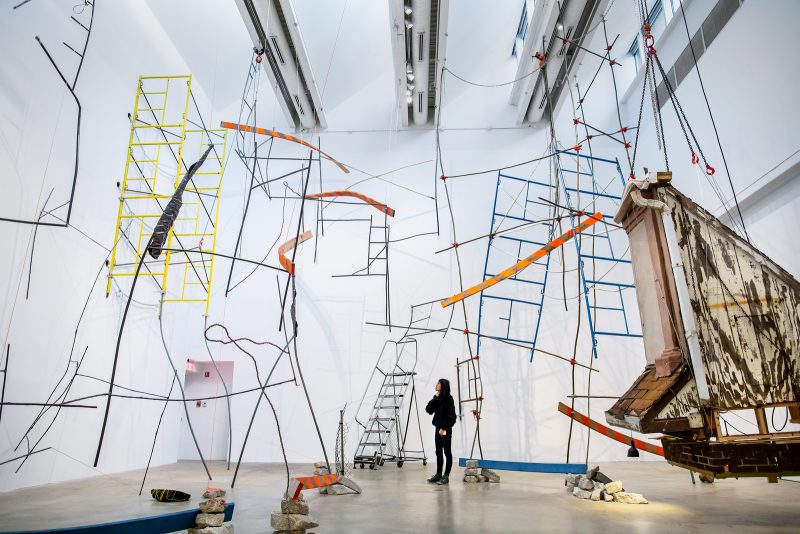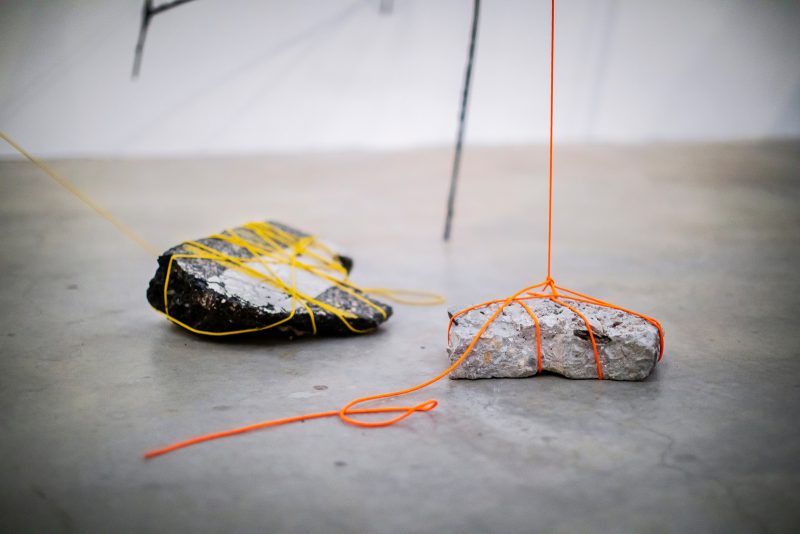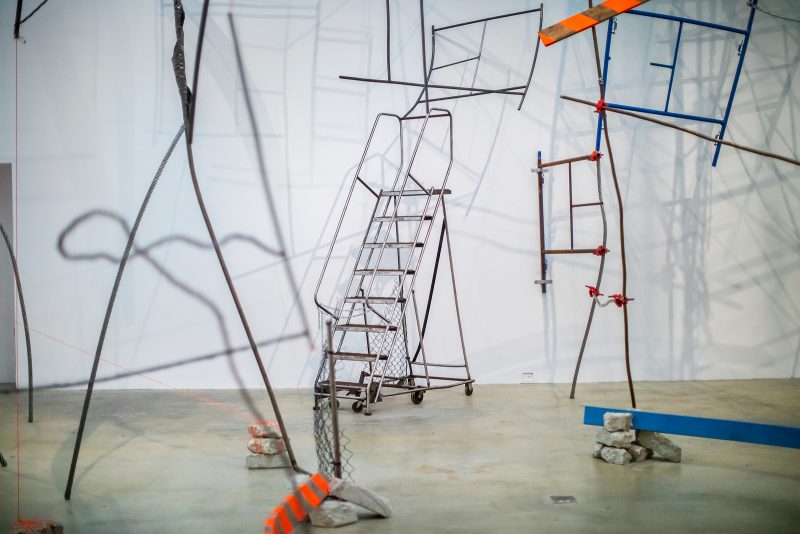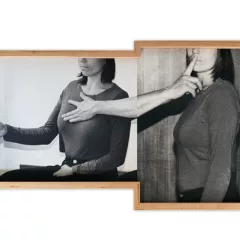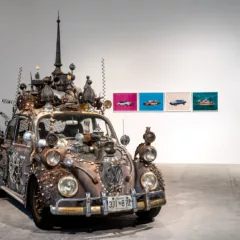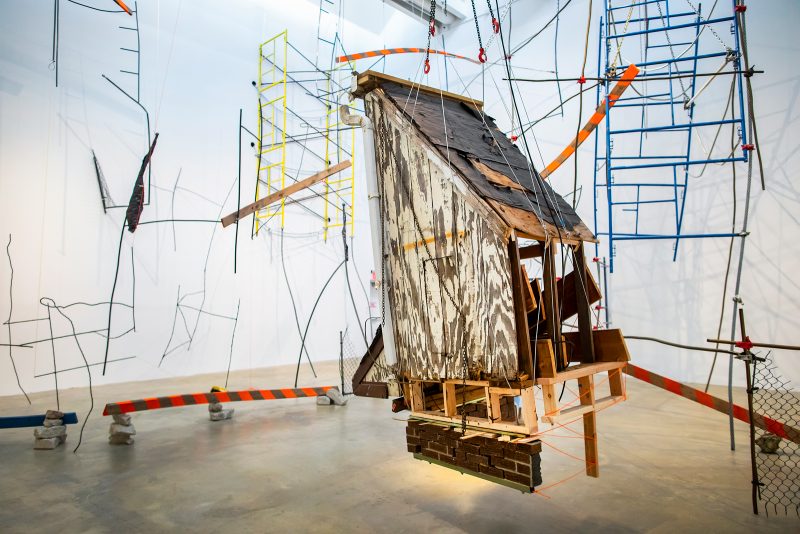
Walking into the Michelle Lopez show Ballast & Barricades at the ICA is to be shocked by verticality. By the stretch and depth of the space fully used and filled in all dimensions.
In the title piece, construction scaffolding floats free, bending, balanced sparsely on narrow feet of piping and serpentine metal cabling. Some sections don’t touch the floor at all. The assemblage seems like it should not be able to stand, and yet it floats, hovering mid lift-off. Barricades twist along the ground and through the air, the echoing blue and orange bars like a refrain. How many times have I seen a warped and discarded pile in a pile like the forms of a collapsed alphabet. Some pieces of Ballast and Barricades hanging entirely in the air, are, upon closer inspection, bolted to walls, but these structural bolts secured through portals cut into the wall are camouflaged by the whimsical bolts and ports which punctuate the space.
It’s impossible to back out enough to look at any one section alone. The piece is around, above, in front of and behind you. You wander through it. If you are close enough to see one part of the piece well, you are too close to see all of it. Backing out, everything else comes out of focus. The shadows on the walls participate in the mark-making, rendering the space not unlike a painting. The colors, materials, although industrial, have an undeniably airy feeling.
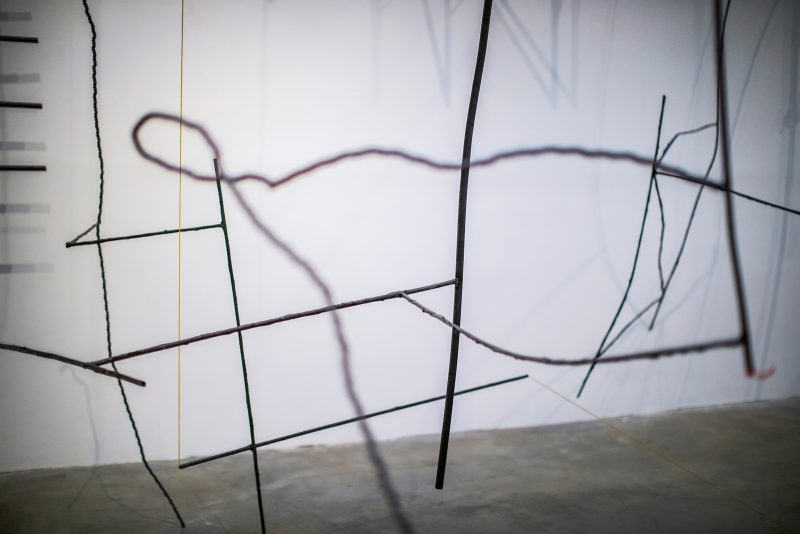
“I call it the metal ballet,” says one of the gallery guards. “Don’t walk between the pieces,” says the next gallery guard on duty after staring me down for several minutes. I’ve loved coming to a place like the ICA, the guards often talk and sit and share, but particular members still make me feel observed in a way that makes me anxious and resentful.
Ballast & Barricades hangs like a giant sketch, a shapeshifting ode to possibility within the tenuous, the temporary, stodgy, daily, commercial and structurally pre-determined construction zone of Capital.
Car paint on the scaffolding plays with a kind of hard-femme dress-up of raw edges. It asks, what is worthy of adornment? How do you adorn the thing that must be ready for the street, exposed to the elements? To do so requires the admission that the product must still, although shiny, be tough as nails.

In one of the smaller pieces, a silhouette of a flagpole, barricade, and shred of fencing painted powder-coated black. It becomes a small, daily echo of the US Marine Corps War Memorial sculpture, the one where several marines struggle to plant an American flag together. The piece by Michelle Lopez instead illustrates a more quotidian war-zone, inserts a question about what constitutes victory here, saying look, this little shred of lyricism is available in the tattered edge of fencing, the broken boundary of capital, rather than the raising of a billowing flag which is instead here is instead seen tilting, falling.
Flags and their attendant meanings are questioned, and at issue here. Just outside the gallery a large pole with cabling. A flag pole. The sound of fabric billowing and cracking in a fierce wind comes down from the ceiling. This is the ominous reminder of what we are under. It is the invisible sign under which the rest of the show takes place. It is partially this piece that lends the others a sense of embattlement and possibility.
There is hope in this war-zone, where the elements of capital are seen warped and bent into a poem about their own decay, malleability, potential and impermanence. A sense that all of the constituent parts may be re-ordered, that the world is reshaping itself under invisible, but deadly real flows of power. It calls us with fascination to pay attention to the ways the structures of our lives are being unsettled and may be repurposed, made beautiful, subverted, reclaimed shaped into a improbable, but strong ballet.
“Michelle Lopez: Ballast & Barricades,” through May 10, 2020, Institute of Contemporary Art, University of Pennsylvania, 118 S. 36th St, Philadelphia, PA
More Photos
